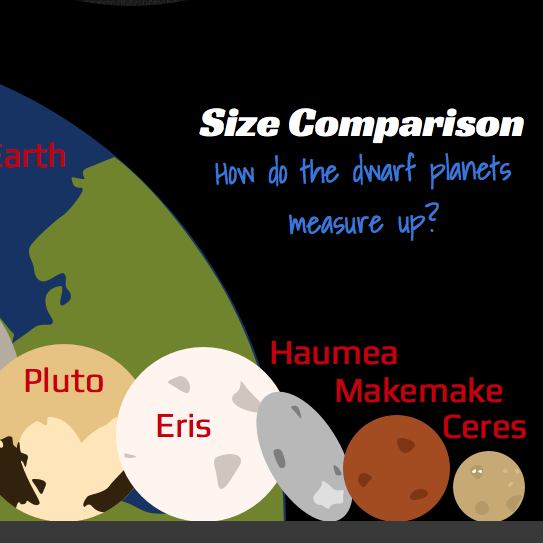Pluto and the Dwarf Planets
Since its discovery in 1906, Pluto held the title of the 9th planet from the Sun. In 2006, Pluto was demoted after the discovery of 2 large planetoids orbiting nearby. The decision came down to adding 2 new planets or removing Pluto. In the end, it was decided that Pluto and the new planetoids should form a new group called the dwarf planets.
Planet vs. Dwarf Planet
WHAT IS A DWARF PLANET ANYWAYS?
| Planet | Dwarf Planet | |
| Orbits the Sun and isn’t a moon | ✓ | ✓ |
| Enough mass to hold a spherical shape | ✓ | ✓ |
| Orbital path is cleared of other objects | ✓ | ✗ |
IN OTHER WORDS…
The main difference between a planet and a dwarf planet is that dwarf planets orbit within debris fields. Pluto lies within the Kuiper belt, similar to the asteroid belt in that there are a large number of objects orbiting within the same space.
The Dwarf Planets
DON’T THINK OF IT AS LOSING A PLANET, BUT AS GAINING A DWARF PLANET (OR FIVE)
Ceres – 963 km across
The largest asteroid and smallest known dwarf planet
Pluto – 2,370 km across
The largest dwarf planet, has 5 moons
Makemake – 1,434 km across
Appears to be red in color
Eris – 2,326 km across
Almost as large as Pluto, has one known moon
Haumea – 1,920 km x 990 km across
Rotates once every 4 hours, so fast its shape is stretched into an oblong sphere. Two known moons.
Asteroid & Kuiper Belts
HOME OF THE DWARF PLANETS
Asteroid Belt
Home to the dwarf planet Ceres which contains about a quarter of the entire mass of the asteroid belt. The asteroids are thought to be leftover material from a planet that failed to form due to gravitational disturbances from Jupiter.
Kuiper Belt
The Kuiper belt lies beyond Neptune and appears to be doughnut-shaped. The rest of the dwarf planets reside here.
Want to learn more about the Solar System?
Interactive Minds: Solar System is a science book app for the iPad that contains 58 pages and is filled with images, videos, and interactive simulations. Try the lite version for free!
References
http://www.astropa.unipa.it/HISTORY/hoskin.html
http://aa.usno.navy.mil/faq/docs/minorplanets.php
http://adsabs.harvard.edu/full/1946ASPL….5…73T
http://dawnblog.jpl.nasa.gov/2015/05/28/dawn-journal-may-28-2015/
http://pluto.jhuapl.edu/News-Center/News-Article.php?page=20150713
http://arxiv.org/abs/1402.4456
http://arxiv.org/abs/1304.1041v1
http://meetingorganizer.copernicus.org/EPSC-DPS2011/EPSC-DPS2011-137-8.pdf
http://solarsystem.nasa.gov/planets/profile.cfm?Object=Dwarf&Display=Sats
